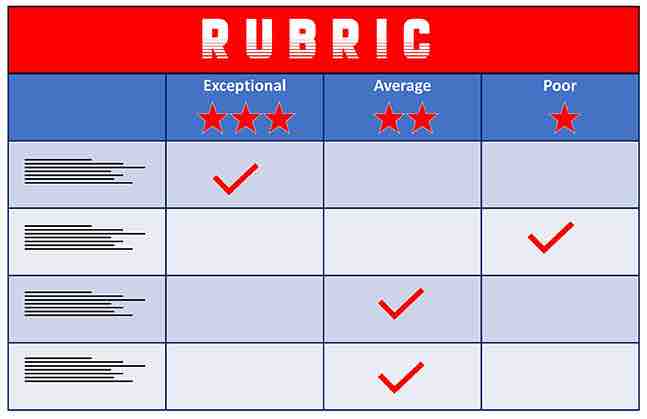How To Design Rubrics For Project-Based Learning

PBL assessments should be authentic, which is to say that they should be structured so that students can display their understanding of problems and their solutions in contextually-meaningful ways (Gallagher, 1997). Clearly, multiple-choice assessments and even short-answer or essay questions that require rote repetition of facts will be of little value in assessing the extent to which students have internalized holistic approaches to complex problems.
To address this type of authentic learning, teachers are encouraged to discard outdated evaluative methods in favor of assessment systems designed to provide information required to improve performance. The concept of performance assessment tries to answer the question: Can the student perform the task? It is not whether they remember how to solve problems and not whether they remember the domain content required to solve problems. Rather, can the students solve problems similar to the ones they have been taught? Can they perform problem solving? How well did they solve the problem?
Performance assessment includes these elements:
- Students must construct a response or a product rather than simply select from a set of predefined alternatives or answers.
- Assessment consists of direct observation or assessment of student behavior on problem-solving tasks.
- Assessment of the quality of the product or observation using a rubric that is, a description of desirable performance.
Constructing Rubrics
In order to assess performance, it is necessary to construct descriptors of the required actions, thoughts and operations so that we know what good performance is. These descriptors are called rubrics.
Rubrics describe performance (good performance and bad performance). They often take the form of a scale or set of scales used to assess a complex performance but also used to improve performance by the student.
There is no single right way to go about developing a rubric, the following set of rules will help provide some direction.
- Start by writing a few sentences that define the importance of the topic of the rubric.
- Why should learners perform this activity
- Make a list of the major “elements” of the activity or topic.
- An element is essentially an important component or criterion of the overall task or activity.
- You should create elements for every aspect of the activity that you want to assess.
- Your elements should be unidimensional – meaning that they should be single items that can’t be reduced to a set of other items.
- You should have somewhere between 3 and 7 elements.. If you need more, create another rubric.
- For each element perform the following steps:
- Define the element
- What activities define the element?
- What is it you wish to see in the student’s performance relative to that element?
- Define the rating scale for each element
- You should not necessarily use the same rating scale for all elements.
- Make sure that the scale is descriptive of the element in question
- Define the meaning of each scale item
- Each must be defined in action or behavior-oriented terms.
- Define the element
- All aspects of a rubric should be focused on providing useful feedback to students that will help them improve their performance
Here are a few examples of simple rubrics that only have one element and that demonstrate the points above:
Assessing the Quality of Comments
| Inadequate | Adequate | Exceptional |
| Comments unrelated to the topic, distract from topic | Comments usually to the point. Occasionally drift from the topic | Comments are always related to topic |
Student Participates in Group Discussion
| Inadequate | Adequate | Exceptional |
| Never participates; quiet, passive | Usually participates as much as others | Always participates. Even more than other group members |
Here is an examples of a rubrics that have multiple elements and that demonstrate the points above:
Rubrics Assessing Intentional Learning
| Elements | Inadequate | Adequate | Exceptional |
| Goal directedness | Learners are pursuing activities that have little to do with achieving project goals | Learners are generally engaged in activities that contribute to achieving project goals | |
| Setting own Goals | Learners are not involved in setting project goals | Learners are sometimes involved in establishing learning goals | Learners are routinely responsible for developing learning goals |
| Regulating own learning | Learners need to be monitored by others | Learners are sometimes involved in monitoring and reporting progress. | Learners are always involved in monitoring and reporting progress |
| Learning how to Learn | Little emphasis is place on understanding the strategies and processes involved in learning (metacognition) | The learning culture emphasizes discussions about the strategies and processes involved in learning | |
| Articulation of goals | Learners fail to see the connection between their activities and the learning goals | Learners direct their activities towards the learning goals | |
| Use technology to support learning goals | Technology use is unrelated to the learning goals | The use of technology contributes to the learning goals | The use of technology is directly related to the learning goals |